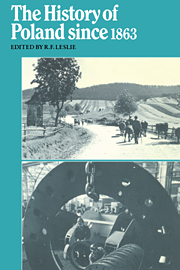Book contents
- Frontmatter
- Contents
- List of maps
- Preface to the paperback edition
- Abbreviations
- Map 1 Poland in the nineteenth century
- 1 Triloyalism and the national revival
- 2 Poland and the crisis of 1900–7
- 3 Poland on the eve of the First World War
- 4 The emergence of an independent Polish state
- 5 The breakdown of parliamentary government
- 6 Piłsudski in power, 1926–35
- 7 Poland without Piłsudski
- 8 Poland in defeat, September 1939–July 1941
- 9 The ill-fated alliance, August 1941–April 1943
- 10 The years of Tempest, May 1943–December 1944
- 11 Post-war Poland
- 12 The rise and ebb of stalinism
- 13 The October turning point
- 14 ‘The little stabilization’
- 15 The decline of Gomułka
- 16 Poland under Gierek
- 17 Polish society, 1945–75
- Epilogue: The rise and fall of Solidarity
- Notes
- Select bibliography
- Index
12 - The rise and ebb of stalinism
Published online by Cambridge University Press: 26 December 2009
- Frontmatter
- Contents
- List of maps
- Preface to the paperback edition
- Abbreviations
- Map 1 Poland in the nineteenth century
- 1 Triloyalism and the national revival
- 2 Poland and the crisis of 1900–7
- 3 Poland on the eve of the First World War
- 4 The emergence of an independent Polish state
- 5 The breakdown of parliamentary government
- 6 Piłsudski in power, 1926–35
- 7 Poland without Piłsudski
- 8 Poland in defeat, September 1939–July 1941
- 9 The ill-fated alliance, August 1941–April 1943
- 10 The years of Tempest, May 1943–December 1944
- 11 Post-war Poland
- 12 The rise and ebb of stalinism
- 13 The October turning point
- 14 ‘The little stabilization’
- 15 The decline of Gomułka
- 16 Poland under Gierek
- 17 Polish society, 1945–75
- Epilogue: The rise and fall of Solidarity
- Notes
- Select bibliography
- Index
Summary
The first years of communist rule in Poland differed in important respects from the subsequent period. The power of the PPR, backed by an efficient political organization controlling the apparatus of government, including the security police and the army, and backed ultimately by the might of the Soviet army stationed to the east and west of Poland, was overwhelming. The Party was not yet the only organized political force, nor did it control society completely. Mikolajczyk's PSL, before its collapse in 1947, and the PPS, despite its name not a continuation of the pre-war Polish Socialist Party but a new pro-communist organization, exercised considerable influence. Industry was mostly state-owned, but private enterprise in trade, handicrafts, the services and, above all, peasant farming still played an essential role in the economy. In education, art and intellectual life the communists and their sympathizers were a minority incapable of changing the character of the national culture according to a predetermined marxist pattern. The Party's rule was superimposed on a society still shaped largely by its non-communist past. While the grip of the Party steadily tightened in the first four years, it was not yet all-powerful. The concept of ‘the Polish road to socialism’, which the PPR officially accepted until the fall of Gomulka, implied that traditional outlooks might be tolerated for some time at least. This situation depended upon the attitude of the USSR. Up to 1948 Stalin was ready to accept something short of Soviet-type communism on his doorstep for various reasons.
- Type
- Chapter
- Information
- The History of Poland Since 1863 , pp. 299 - 343Publisher: Cambridge University PressPrint publication year: 1980



